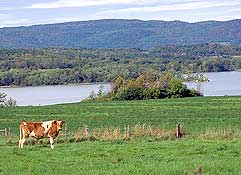
Water
Pollution: Agriculture
 Agriculture
is a common contributor to non-point-source pollution. Pesticides and
fertilizers from crop fields, as well as animal wastes from feed lots,
are often carried in runoff to streams.
Pesticides are generally toxic and may lead to immediate health problems
— even death — within the stream. Fertilizers and animal wastes,
however, tend to enrich streams with large amounts of nutrients such as
nitrogen and phosphorus.
The immediate result of increased nutrients in a stream is increased growth
of aquatic plants. While this may seem beneficial at first glance, it
is actually quite harmful to the ecosystem. The overabundance of plants
leads to an overabundance of plant detritus
on the streambed at the end of the growing season. Microbes on the
streambed must then use larger amounts of oxygen in order to decompose
the increased amount of dead plant material. This leads to a depletion
of the amount of dissolved oxygen in
the streamwater. Macroinvertebrates and
larger aquatic animals such as fish can die from a lack of oxygen. With
the death of herbivorous (plant-eating) animals, the aquatic plant population
will continue to increase. The use of oxygen by microbial decomposers
will also continue to increase. This positive
feedback process is referred to as eutrophication.
Photo
© 1994 philg@mit.edu
Agriculture
is a common contributor to non-point-source pollution. Pesticides and
fertilizers from crop fields, as well as animal wastes from feed lots,
are often carried in runoff to streams.
Pesticides are generally toxic and may lead to immediate health problems
— even death — within the stream. Fertilizers and animal wastes,
however, tend to enrich streams with large amounts of nutrients such as
nitrogen and phosphorus.
The immediate result of increased nutrients in a stream is increased growth
of aquatic plants. While this may seem beneficial at first glance, it
is actually quite harmful to the ecosystem. The overabundance of plants
leads to an overabundance of plant detritus
on the streambed at the end of the growing season. Microbes on the
streambed must then use larger amounts of oxygen in order to decompose
the increased amount of dead plant material. This leads to a depletion
of the amount of dissolved oxygen in
the streamwater. Macroinvertebrates and
larger aquatic animals such as fish can die from a lack of oxygen. With
the death of herbivorous (plant-eating) animals, the aquatic plant population
will continue to increase. The use of oxygen by microbial decomposers
will also continue to increase. This positive
feedback process is referred to as eutrophication.
Photo
© 1994 philg@mit.edu
Another indicator of agricultural pollution is the presence of the microbe fecal coliform. Fecal coliform is a non-pathogenic bacteria that naturally occurs in the digestive tracks of warm-blooded animals. "Non-pathogenic" means fecal coliform does not cause diseases. However, it is often found in association with pathogenic (disease-causing) organisms.
Loose dirt, or sediments, from plowed fields is also a form of agricultural pollution. Like pesticides, fertilizers, and animal wastes, dirt from plowed fields can be carried by runoff to streams. Sediments cause increased suspended solids in streamwater. The suspended solids decrease light penetration through the water column. When the sediments finally settle to the bottom of the stream, they suffocate life there. This movement of loose dirt into streams is called siltation. The murkiness of the water is referred to as turbidity.
The problem of pesticides, fertilizers, animal wastes, and sediments in runoff can be increased by livestock grazing along the stream. Vegetation that grows near streams acts as a buffer. This vegetation absorbs toxins and nutrients and traps sediments before they reach the stream. Livestock remove the vegetation. Without a vegetation buffer, pollutants can move freely from a field into a stream. In addition, livestock increase erosion of banks along streams, and thereby increase the occurrence of siltation.
Overview
..|.. Acid
Mine Drainage ..|..
Agriculture
..|.. Sewage
..|.. Dredging Home
..|..
Teacher Pages
..|..
Modules
& Activities
Glossary .|.
Related Links
.|..
References
..|..
PBL Model
.|
HTML code by Chris Kreger
Maintained by ETE Team
Last updated November 10, 2004
Some images © 2004 www.clipart.com
Privacy Statement and Copyright © 1997-2004 by Wheeling Jesuit University/NASA-supported Classroom of the Future. All rights reserved.
Center for Educational Technologies, Circuit Board/Apple graphic logo, and COTF Classroom of the Future logo are registered trademarks of Wheeling Jesuit University.